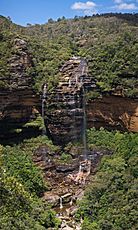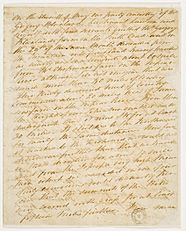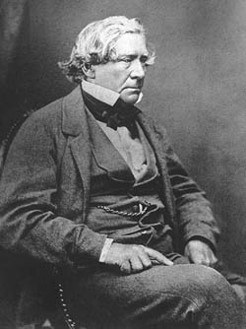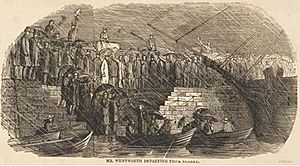William Wentworth facts for kids
Quick facts for kids
William Wentworth
|
|
|---|---|
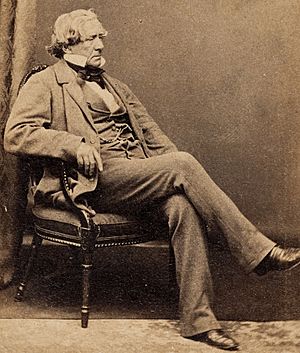
William Charles Wentworth, 1861-1862, Dalton's Royal Photographic Gallery
|
|
| 4th President of the New South Wales Legislative Council | |
| In office 24 June 1861 – 10 October 1862 |
|
| Deputy | George Allen |
| Preceded by | William Westbrooke Burton |
| Succeeded by | Terence Aubrey Murray |
| Member of the New South Wales Legislative Council | |
| In office 3 September 1861 – 10 October 1862 Life appointment |
|
| In office 1 June 1843 – 1 April 1854 |
|
| Preceded by | Position established |
| Succeeded by | Henry Parkes |
| Constituency | City of Sydney |
| Personal details | |
| Born |
William Charles Wentworth
August 1790 Aboard Surprize, Norfolk Island, Colony of New South Wales |
| Died | 20 March 1872 (aged 81) Wimborne, Dorset, England, United Kingdom |
| Nationality | British |
| Spouse | Sarah Cox |
| Children | 11 |
| Parent |
|
| Alma mater | |
| Occupation | Lawyer, Pastoralist, Politician |
William Charles Wentworth (August 1790 – 20 March 1872) was an important figure in early Australian history. He was an explorer, a newspaper editor, a lawyer, and a politician. He became one of the richest and most powerful people in the early New South Wales colony.
Through his newspaper, The Australian, William Wentworth helped create the idea of Australian nationalism. This means he was one of the first to promote a sense of Australian identity. He also strongly supported self-government for the Australian colonies. He believed that wealthy landowners, called squatters, should control this new government. His critics jokingly called this idea the "bunyip aristocracy".
Contents
William Wentworth's Birth and Family
William Charles Wentworth was born in August 1790. He was born on a ship called HMS Surprize near Norfolk Island. His mother was Catherine Crowley, and his father was D'Arcy Wentworth. D'Arcy Wentworth was from an important family in England and Ireland. He came to the colony of New South Wales as an assistant surgeon.
Because his parents were not married, there was some confusion about William's exact birth date. However, his father accepted him as his son. William grew up as a recognized member of the Wentworth family in the colony.
William's Early Life and Education
In 1796, William Wentworth moved from Norfolk Island to Sydney with his family. They lived in Parramatta, where his father became a successful landowner. William's mother passed away in 1800. In 1803, William and his brothers, Dorset and Matthew, went to England. They attended a special school in Greenwich.
William tried to get into important colleges but was not successful. He returned to Sydney in 1810. He became a jockey and won a horse race at Hyde Park. This was one of the first official horse races in Australia.
In 1811, Governor Lachlan Macquarie gave him a job as acting Provost Marshal. William also received a large land grant of 1,750 acres (about 708 hectares). This land was along the Nepean River, and he named it Vermont.
Exploring the Blue Mountains
In 1813, William Wentworth, along with Gregory Blaxland and William Lawson, led an important expedition. They found a way to cross the Blue Mountains west of Sydney. This discovery opened up new areas for grazing animals in inland New South Wales.
The town of Wentworth Falls in the Blue Mountains is named after him. As a reward for his exploration, he received another 1,000 acres (about 405 hectares) of land.
In 1814, William Wentworth went on another adventure. He joined a trip to collect sandalwood in the South Pacific. During this trip, five crew members were killed in a conflict with local people in Rarotonga. William himself almost died but managed to escape.
Studying Law and Writing in England
William Wentworth went back to England in 1816. He studied law at Cambridge University. He became a lawyer in 1822.
He also became a writer. In 1819, he published a book called A Statistical, Historical, and Political Description of the Colony of New South Wales. In this book, he argued for important changes in New South Wales. He wanted an elected assembly, a free press, and trials by jury. He also believed that free settlers, not convicts, should populate Australia.
In 1823, he published a long poem called Australasia. This poem showed his vision for Australia as a "new Britannia in another world."
While studying and writing, Wentworth also traveled in Europe, especially in Paris. He dreamed of becoming a leader of wealthy landowners in New South Wales. He tried to marry Elizabeth Macarthur, whose father, John Macarthur, was very influential. However, the marriage did not happen due to disagreements.
Becoming an Influential Colonist

William Wentworth returned to Sydney in 1824 with another lawyer, Robert Wardell. They started The Australian newspaper. This was the colony's first privately owned newspaper. It supported the rights of former convicts, known as emancipists. The newspaper often disagreed with Governor Ralph Darling. Wentworth also became a director of the Bank of New South Wales in 1825.
In 1827, William's father, D'Arcy Wentworth, passed away. William inherited much of his father's valuable property. This made him one of the richest men in the colony. He bought land in Sydney at Vaucluse and built a large house called Vaucluse House. He also acquired land in Homebush and 12,000 acres (about 4,856 hectares) along the Hunter River.
Becoming a Powerful Landowner
William Wentworth greatly expanded his landholdings. He obtained many large pastoral grazing licenses across New South Wales. These properties were used for sheep and cattle. He acquired huge stations like Yanko (120,000 acres) and Tala (200,000 acres). He often bought these lands for a small annual fee and then sold them for a large profit.
In 1839, Wentworth tried to buy a huge amount of land in New Zealand. He and a group of Sydney investors claimed 8 million hectares (about a third of New Zealand). Governor George Gipps stopped the deal, saying it was unfair to the Māori people. This made Wentworth very angry with Governor Gipps.
A Conservative Politician
In the 1830s, Wentworth supported ideas like free immigration, trial by jury, and elected representatives. In 1835, he and William Bland formed the Australian Patriotic Association. This was one of Australia's first political parties. However, as Wentworth became wealthier, his political views became more conservative.
In 1842, the British government allowed more elected representatives in the Legislative Council of New South Wales. In 1843, Wentworth was elected to the Council for City of Sydney. He became the leader of the conservative group.
Leader of the "Squattocracy"

Wentworth became a strong voice for wealthy landowners in government. He opposed changes that might hurt the "squattocracy" class. He helped remove Governor Gipps in 1846, who wanted to tax squatting licenses more. With Gipps gone, Wentworth helped pass the Squatters' Act of 1848. This law gave landowners very good long-term pastoral leases.
When convict transportation ended in 1840, landowners lost a cheap source of labor. Wentworth then supported bringing in Chinese workers under contract. He used them at his Vaucluse home and on his properties. He was known for treating them harshly.
Wentworth also supported harsh punishments, including the death penalty. He believed it was "beneficial to society." Because of these views, the Australian newspaper, which he no longer owned, said his opinions were not worth much.
In 1853, Wentworth led a group to write a new constitution for New South Wales. This constitution would give the colony more self-government. His plan included a powerful, unelected Legislative Council and an elected Legislative Assembly. However, only wealthy people could vote or be members. He even suggested creating a colonial peerage (a system of titles like lords and ladies) from the landowning class. Critics like Daniel Deniehy made fun of this idea, calling it a "bunyip aristocracy". The final constitution was changed to be more democratic.
Despite some of his views, Wentworth was a strong supporter of education for everyone. He helped start a National School system in 1848. In 1852, he helped found the University of Sydney.
Views on Aboriginal People
In 1819, as a young writer, Wentworth held views that placed Aboriginal Australians at a lower status. He played a role in denying Aboriginal people legal protection during colonization. In 1827, he defended a soldier accused of killing an Aboriginal prisoner. He argued that English law did not protect people who were "just above the beasts." The soldier was found not guilty.
Wentworth also supported stockmen found guilty of killing Aboriginal people in the Myall Creek massacre in 1838. In 1844, he strongly opposed changes that would allow Aboriginal people to give evidence in court.
Wentworth also supported the Native Police. This was a police force that carried out many massacres against Aboriginal people in the 1800s.
Return to England and Death
William Wentworth left the Legislative Council of New South Wales in 1854 and sailed to England. At this time, many people were coming to Australia because of the gold rush. His ideas about using contract labor and creating a colonial peerage made him unpopular. People booed him as he left Sydney.
In England, he started the "General Association for the Australian Colonies." This group aimed to create a federal assembly for all of Australia. He returned to New South Wales briefly in 1860-61 to lead the Legislative Council. However, he mostly stayed in England at his estate, Merly House.
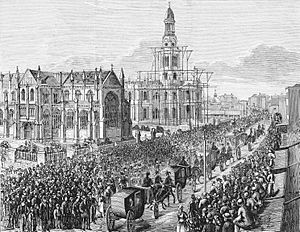

William Wentworth passed away on 20 March 1872 in England. He was a very wealthy man. As he wished, his body was brought back to Sydney for burial. He received the colony's first state funeral on 6 May 1873. This day was declared a public holiday. About 65,000 people watched his funeral procession to Vaucluse. The Wentworth Mausoleum was built over his grave.
William Wentworth's Family
On 26 October 1829, William Wentworth married Sarah Cox in Sydney. They had seven daughters and three sons:
- Thomasine Wentworth (1825–1913)
- William Charles Wentworth (1827–1859)
- Fanny Katherine Wentworth (1829–1893)
- Fitzwilliam Wentworth (1833–1915) married Mary Jane Hill.
- William Charles Wentworth III (1871–1949)
- William Charles Wentworth IV (1907–2003) (known as Bill Wentworth, a politician from 1949–77)
- Diana Wentworth Wentworth
- Mungo Wentworth MacCallum (1941–2020)
- William Charles Wentworth III (1871–1949)
- Sarah Eleanor Wentworth (1835–1857)
- Eliza Sophia Wentworth (1838–1898)
- Isabella Christiana (Christina) Wentworth (1840–1856)
- Laura Wentworth (1842–1887)
- Edith Wentworth (1845–1891)
- D'Arcy Bland Wentworth (1848–1922).
William Wentworth's Legacy
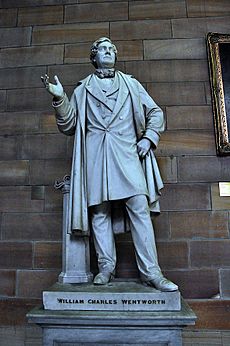
Many places are named after William Wentworth. These include the towns of Wentworth and Wentworth Falls. The federal Division of Wentworth in Sydney and the Wentworth Falls waterfall are also named for him. Wentworth Avenue in Canberra also carries his name.
In 1963, he was honored on a postage stamp with Blaxland and Lawson for their Blue Mountains crossing. He was honored again in 1974 for the anniversary of the first newspaper publication.
The Wentworth Building at the University of Sydney Union was built in 1972 and named after him.
An 8-foot (2.4 meter) tall statue of Wentworth stands at the University of Sydney. Another statue of him is on the outside of the Department of Lands building in Sydney.
Works by William Wentworth
- A Statistical Account of the British Settlements in Australasia (1819)
- Journal of an expedition, across the Blue Mountains, 11 May-6 June 1813 (1813)
- Australasia: a poem written for the Chancellor's Medal at the Cambridge commencement, July 1823 (1823)
See also
 In Spanish: William Wentworth para niños
In Spanish: William Wentworth para niños
- Political families of Australia: Wentworth/Hill/Griffiths/Scott/Cooper family
- Wentworth family


